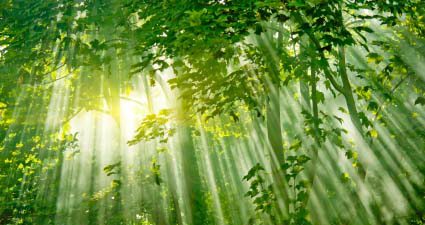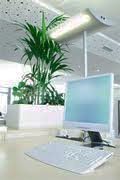Plant Care - Light

All plants need light. In fact their life depends on it!
In nature, plants grow in a variety of light conditions, from dimly lit areas on the forest floor to the full sun of high up in the forest canopy.
Before choosing a plant, determine the light conditions you have to offer. Then, select a plant that matches your light conditions.
Understanding Light
Light Intensity
Light intensity refers to the strength of the light in your growing area.
1.) High Light:
This describes an area that receives 3-4 hours of direct sunlight every day. (Very few indoor plants can withstand direct sun for the entire day.)
2.) Medium Light:
An area that receives about an hour of direct sun with lots of bright, indirect light the rest of the day. Most indoor plants prefer these conditions.
3.) Low Light:
This area gets no direct sun whatsoever. There should be enough light to cast a shadow however. "Can you read the newspaper without turning the lights on?" If you can't, there's not enough light to grow a plant.
When judging light, keep in mind how the sun changes postions in the sky with the seasons.
In the summer, when the sun is high in the sky, East and West windows are a good source for high light. This changes to medium light in the winter when the sun moves to southern skies however.
North windows provide medium light during the summer, but only low light in the winter.
South windows provide only medium light in the summer. Then, as the sun moves south in the winter, these windows become high light areas.
If you're not sure what direction your windows face, use a compass. You can't understand light without knowing what direction it's coming from.
Light Quality
Quality of light refers to the color of the light. Natural sunlight is always the best for growing indoor plants because it's the perfect blend of many colors: red, orange, yellow, green, blue, and violet. Unfortunately, most indoor lighting does not have strong red and blue colors, making it unsuitable for growing indoor plants. That's why you'll have limited success (at best) growing plants under a lamp that's perfect for reading.
On the other hand, fluorescent lights used in offices are great for growing many types of indoor plants because they contain the red and blue rays plants are looking for.
Light Duration
This one is easy. Light duration refers to the photo-period, or length of time light is present. Light duration is greater during the summer when days are longer. As winter approaches and days get shorter, light duration also becomes shorter.
 Plants favor the red and blue rays in flourescent lights found in in many offices
Plants favor the red and blue rays in flourescent lights found in in many officesMeasuring Light
Hold your hand a couple of inches above a sheet of plain white paper. As you move about the room evaluate the shadow your hand casts on the paper.
High Light:
Crisp, clear, dark shadow appears on the paper.
Medium Light:
A light grey, slightly fuzzy shadow appears.
Low Light:
Shadow is barely visiable.